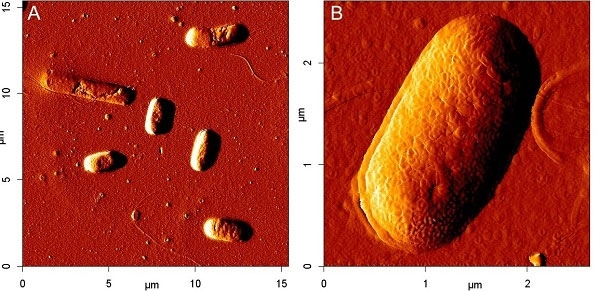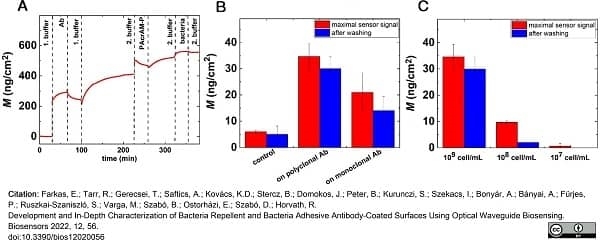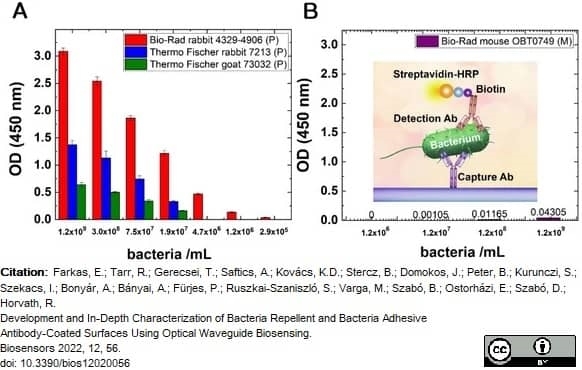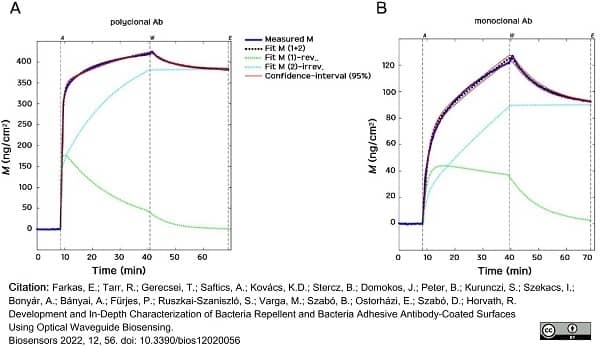Escherichia coli antibody




Rabbit anti Escherichia coli:FITC
- Product Type
- Polyclonal Antibody
- Isotype
- Polyclonal IgG
- Specificity
- Escherichia coli
| Rabbit anti Escherichia coli antibody recognizes Escherichia coli and is broadly reactive with all somatic and capsular (O and K) antigenic serotypes. The somatic O antigens are composed of lipopolysaccharide complexes which form part of the cell wall structure of E. coli whilst the capsular K antigens are mainly composed of acidic polysaccharide. This antibody will remove E.coli proteins from recombinant preparations. Rabbit anti Escherichia coli antibody has not been absorbed and may cross-react with related enterobacteriaceae. Rabbit anti Escherichia coli antibody has been used in ELISA with serotypes O157:H7, O20, O125, 055, 0111 and K12. |
- Target Species
- Bacterial
- Product Form
- Purified IgG conjugated to Fluorescein Isothiocyanate Isomer 1 (FITC) - liquid
- Buffer Solution
- Phosphate buffered saline
- Preservative Stabilisers
0.1% Sodium Azide (NaN3) 1% Bovine Serum Albumin - Immunogen
- A mixture of all antigenic serotypes.
- Approx. Protein Concentrations
- IgG concentration 5.0 mg/ml
- Max Ex/Em
-
Fluorophore Excitation Max (nm) Emission Max (nm) FITC 490 525 - Regulatory
- For research purposes only
- Guarantee
- 12 months from date of despatch
Avoid repeated freezing and thawing as this may denature the antibody. Storage in frost-free freezers is not recommended.
| Application Name | Verified | Min Dilution | Max Dilution |
|---|---|---|---|
| Immunofluorescence | 1/10 | 1/50 |
References for Escherichia coli antibody
-
Tian, B. et al. (2015) Blu-ray optomagnetic measurement based competitive immunoassay for Salmonella detection.
Biosens Bioelectron. 77: 32-9. -
Skladal, P. et al. (2013) Electrochemical immunosensors for detection of microorganisms
Int. J. Electrochem. Sci., 8 1635 - 49 -
Su, W.H. et al. (2013) Development of a chip-based multiplexed immunoassay using liposomal nanovesicles and its application in the detection of pathogens causing female lower genital tract infections.
Taiwan J Obstet Gynecol. 52: 25-32. -
Ho, T.Y. et al. (2013) Development of a novel bead-based 96-well filtration plate competitive immunoassay for the detection of Gentamycin.
Biosens Bioelectron. 49: 126-32. -
Ong, L.C. et al. (2014) Bacterial imaging with photostable upconversion fluorescent nanoparticles.
Biomaterials. 35 (9): 2987-98. -
Pivetal, J. et al. (2014) Micro-magnet arrays for specific single bacterial cell positioning
J. Magnetism and magnetic Materials 380 72-7. -
Farka, Z. et al. (2014) Rapid Detection of Microorganisms Based on Active and Passive Modes of QCM
Sensors. 15 (1): 79-92. -
Dayam RM et al. (2015) The Phosphoinositide-Gated Lysosomal Ca(2+) Channel, TRPML1, Is Required for Phagosome Maturation.
Traffic. 16 (9): 1010-26.
View The Latest Product References
-
Farka, Z. et al. (2015) Quartz crystal microbalance biosensor for rapid detection of aerosolized microorganisms.
Proc. SPIE 9455, Chemical, Biological, Radiological, Nuclear, and Explosives (CBRNE) Sensing XVI, 945507 -
Bhokisham, N. et al. (2016) Modular construction of multi-subunit protein complexes using engineered tags and microbial transglutaminase.
Metab Eng. 38: 1-9. -
Kovář, D. et al. (2014) Detection of aerosolized biological agents using the piezoelectric immunosensor.
Anal Chem. 86 (17): 8680-6. -
VanGerven, N. et al. (2014) Secretion and functional display of fusion proteins through the curli biogenesis pathway.
Mol Microbiol. 91 (5): 1022-35. -
Rodrigues, D.M.C. et al. (2017) Sensitivity Analysis of Different Shapes of a Plastic Optical Fiber-Based Immunosensor for Escherichia coli: Simulation and Experimental Results.
Sensors (Basel). 17 (12) Dec 19 [Epub ahead of print].
- RRID
- AB_616821
Please Note: All Products are "FOR RESEARCH PURPOSES ONLY"
View all Anti-Bacterial ProductsAlways be the first to know.
When we launch new products and resources to help you achieve more in the lab.
Yes, sign me up


